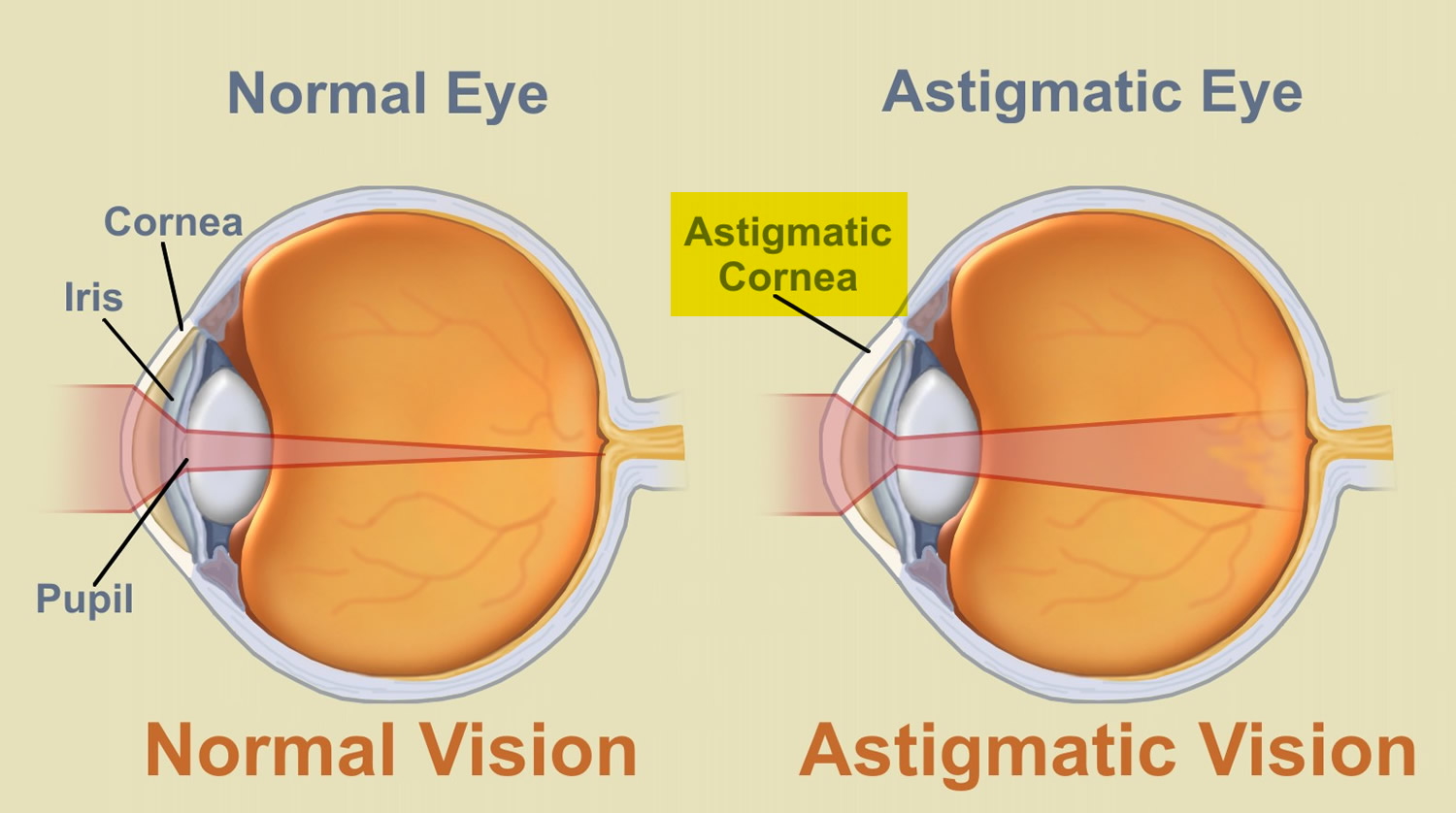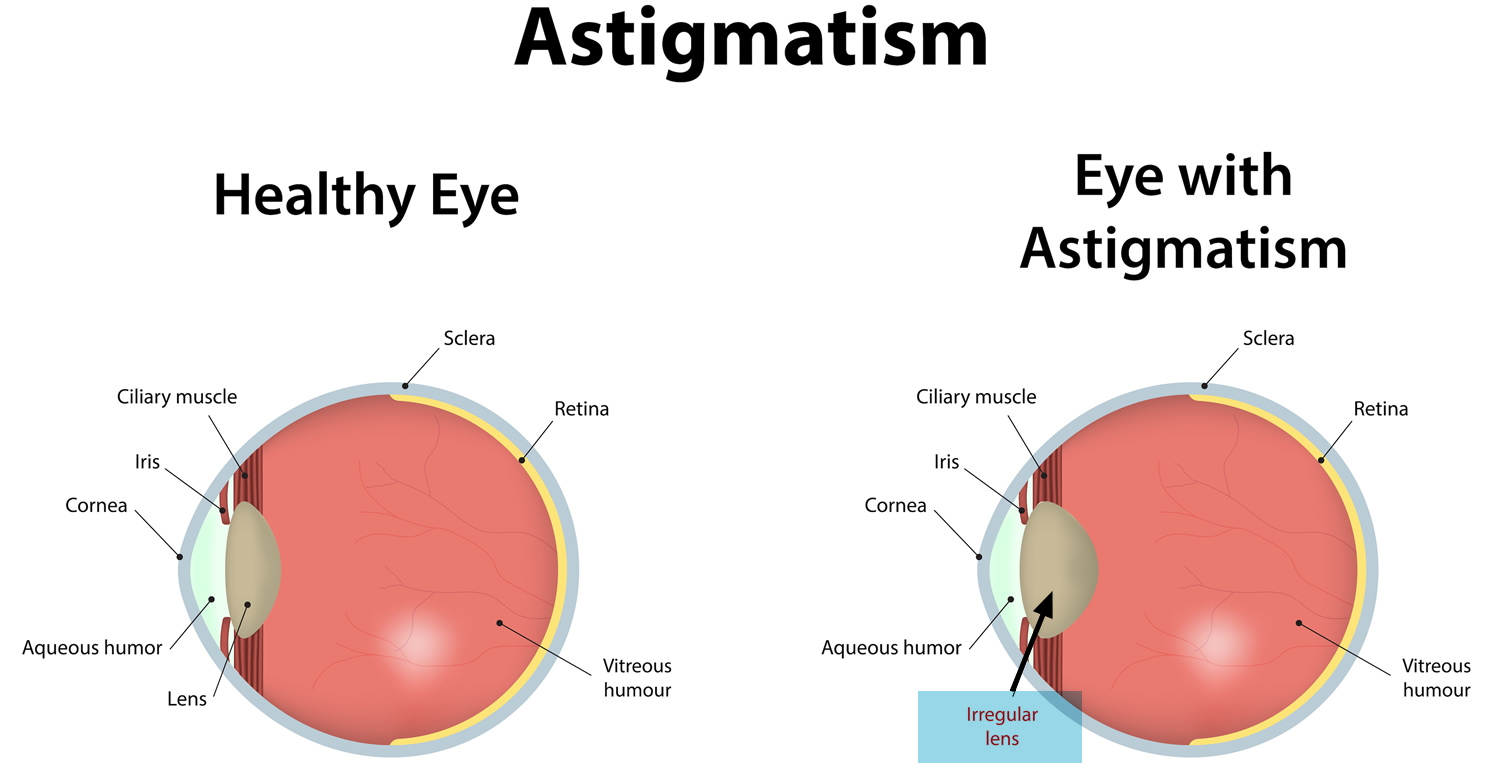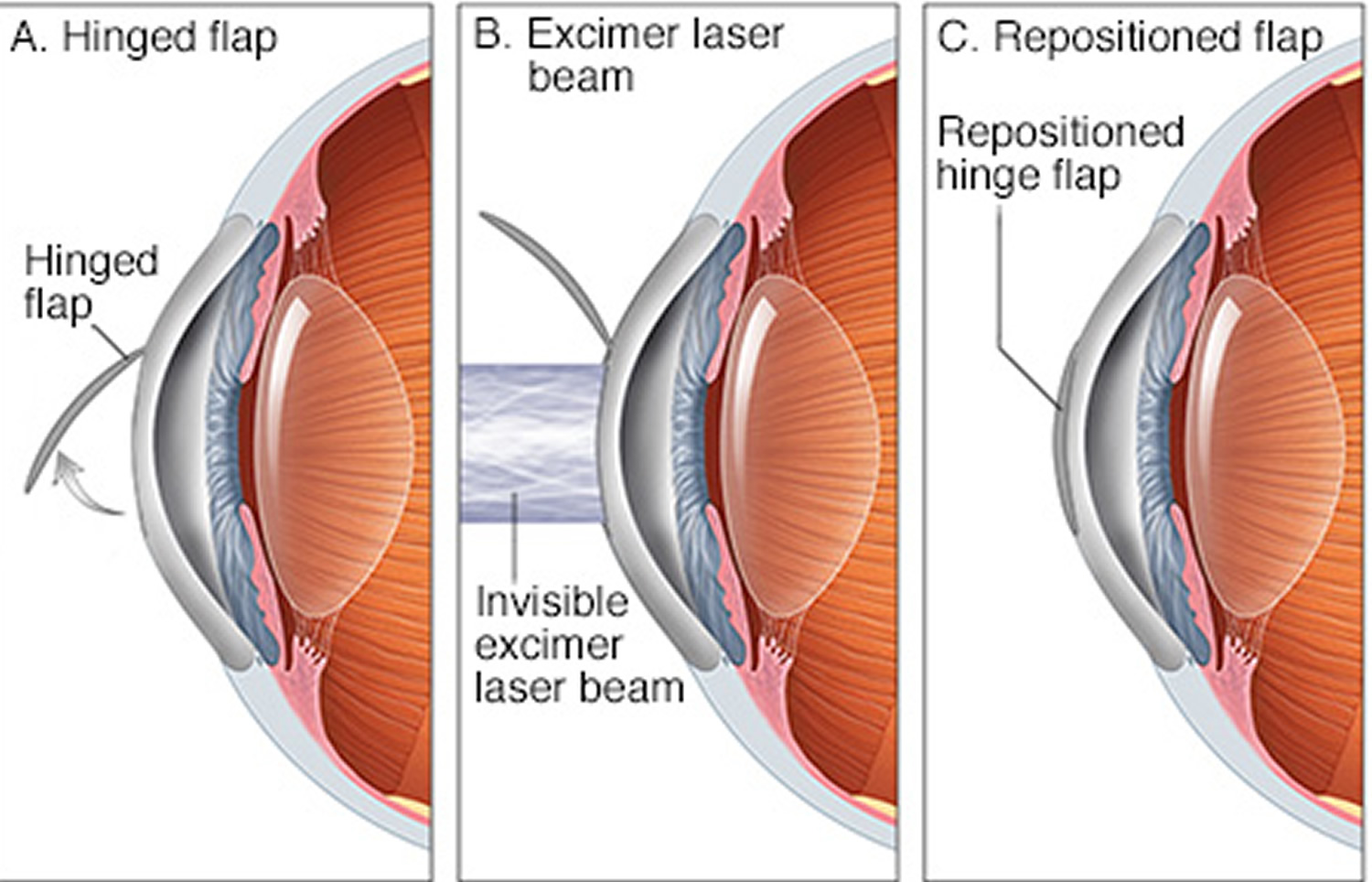Contents
What is hyperopia
Hyperopia, also known as farsightedness or hypermetropia, is a common type of refractive error where distant objects may be seen more clearly than objects that are near (see Figure 1). However, people experience hyperopia (farsightedness) differently. Some people may not notice any problems with their vision, especially when they are young. For people with significant hyperopia, vision can be blurry for objects at any distance, near or far.
People who are more long-sighted, or who do a lot of near-focus activities such as reading, need more adjustment, so their eyes can get tired and they might get headaches.
Vision occurs when light rays are bent (refracted) as they pass through the cornea and the lens. The light is then focused on the retina (see Figure 3). The retina converts the light-rays into messages that are sent through the optic nerve to the brain. The brain interprets these messages into the images you see.
Hyperopia (farsighted vision) develops in eyes that focus images behind the retina instead of on the retina, which can result in blurred vision. This occurs when the eyeball is too short, which prevents incoming light from focusing directly on the retina (compare Figures 1 and 3). It may also be caused by an abnormal shape of the cornea or lens.
Many people are slightly long-sighted and the lens corrects for the refractive error by adjusting the focus to get a sharp image.
If you’re farsighted, you may:
- find that nearby objects are fuzzy and out of focus, but distant objects are clear
- have to squint to see clearly
- have tired or strained eyes after activities that involve focusing on nearby objects, such as reading, writing or computer work
- experience headaches
Children who are farsighted often don’t have obvious issues with their vision at first. But if left untreated, it can lead to problems such as a squint or lazy eye.
Hyperopia can affect both children and adults. It affects about 5 to 10 percent of Americans (see Table 1 and Figure 4 below). People whose parents have hyperopia may also be more likely to get the condition.
Farsighted with astigmatism
Astigmatism is an imperfection in the curvature of your cornea — the clear, round dome covering the eye’s iris and pupil (see Figure 5 below) — or in the shape of the eye’s lens (see Figure 6 below) 1. Instead of having one curve like a round ball, the surface is egg shaped. If your cornea or lens isn’t smooth and evenly curved, light rays aren’t refracted properly. This is called a refractive error. Astigmatism is a common type of refractive error. It is a condition in which the eye does not focus light evenly onto the retina, the light-sensitive tissue at the back of the eye 2. This causes blurred vision at all distances.
Astigmatism is often present at birth and may occur in combination with nearsightedness or farsightedness. Often it’s not pronounced enough to require corrective action. When it is, your treatment options are corrective lenses or surgery.
The goal of treating astigmatism is to improve vision clarity and eye comfort. Treatments are corrective lenses or refractive surgery, which is the same as the treatment for farsightednes (hyperopia).
Figure 1. Hyperopia (farsighted vision)
Figure 2. Structure of the human eye
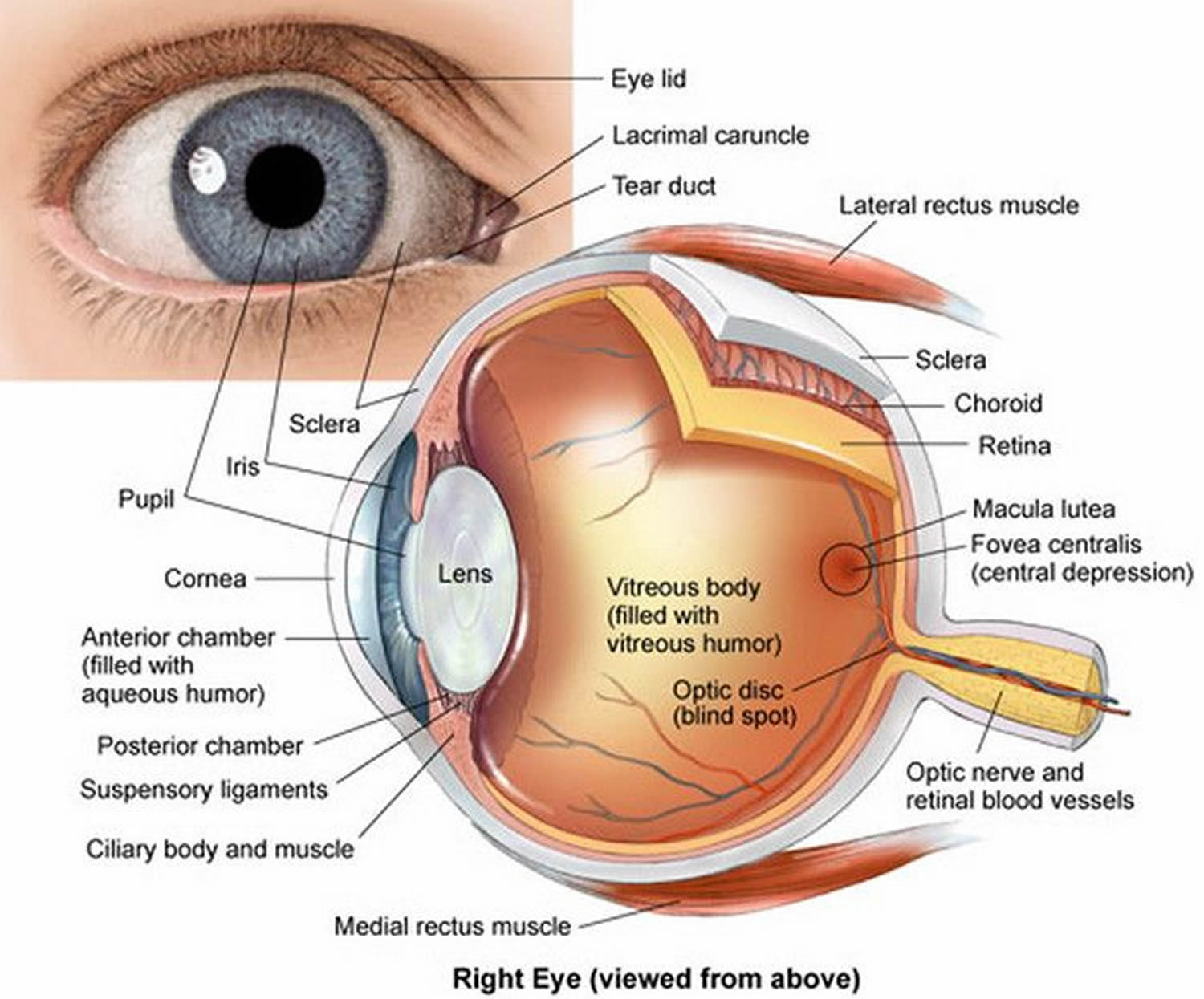 Note: Your eye is a complex and compact structure measuring about 1 inch (2.5 centimeters) in diameter. It receives millions of pieces of information about the outside world, which are quickly processed by your brain.
Note: Your eye is a complex and compact structure measuring about 1 inch (2.5 centimeters) in diameter. It receives millions of pieces of information about the outside world, which are quickly processed by your brain.Figure 3. Normal eye refraction (perfect image on the Macula’s Fovea)
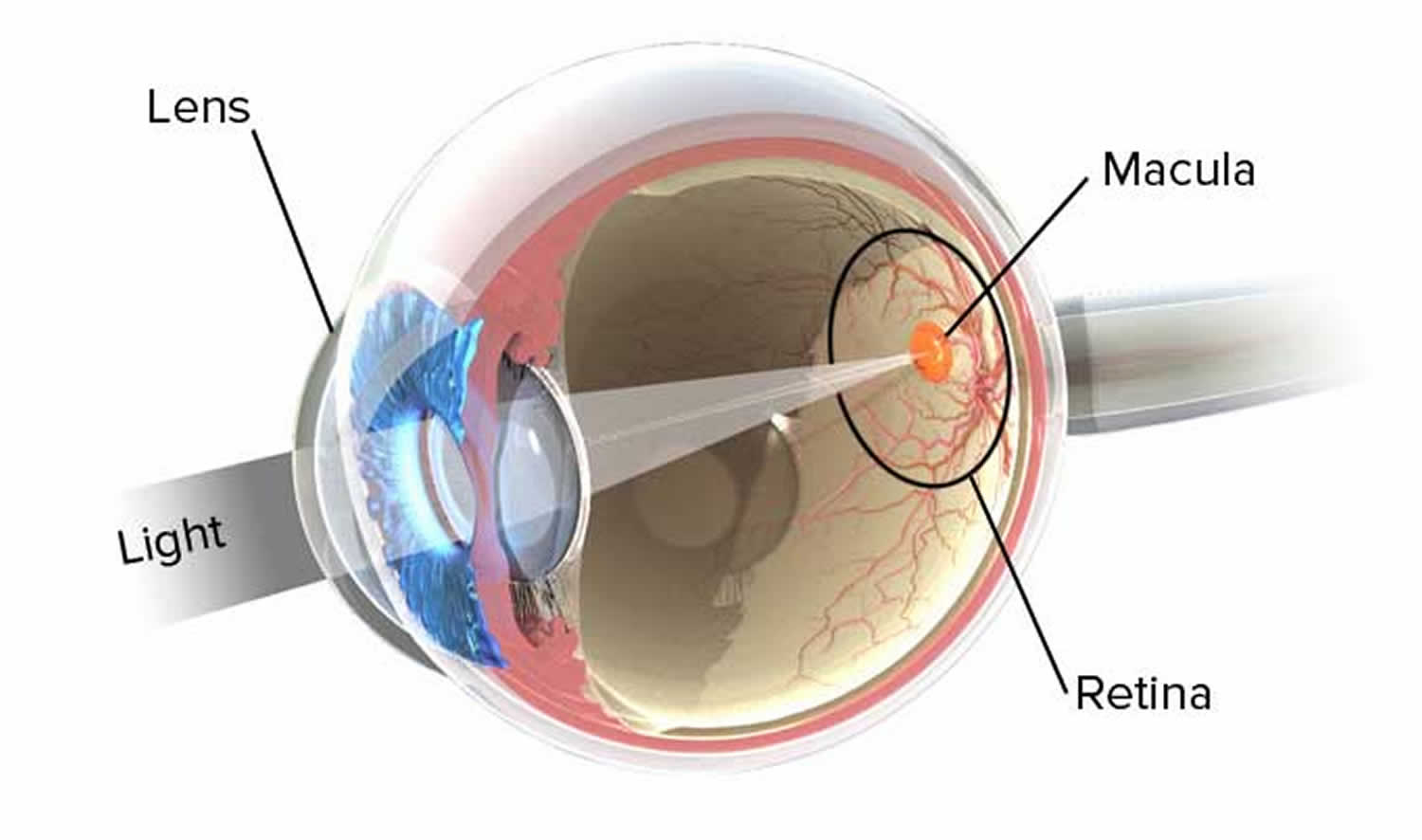
Figure 4. 2010 U.S. Age-Specific Prevalence Rates for Hyperopia by Age, and Race/Ethnicity
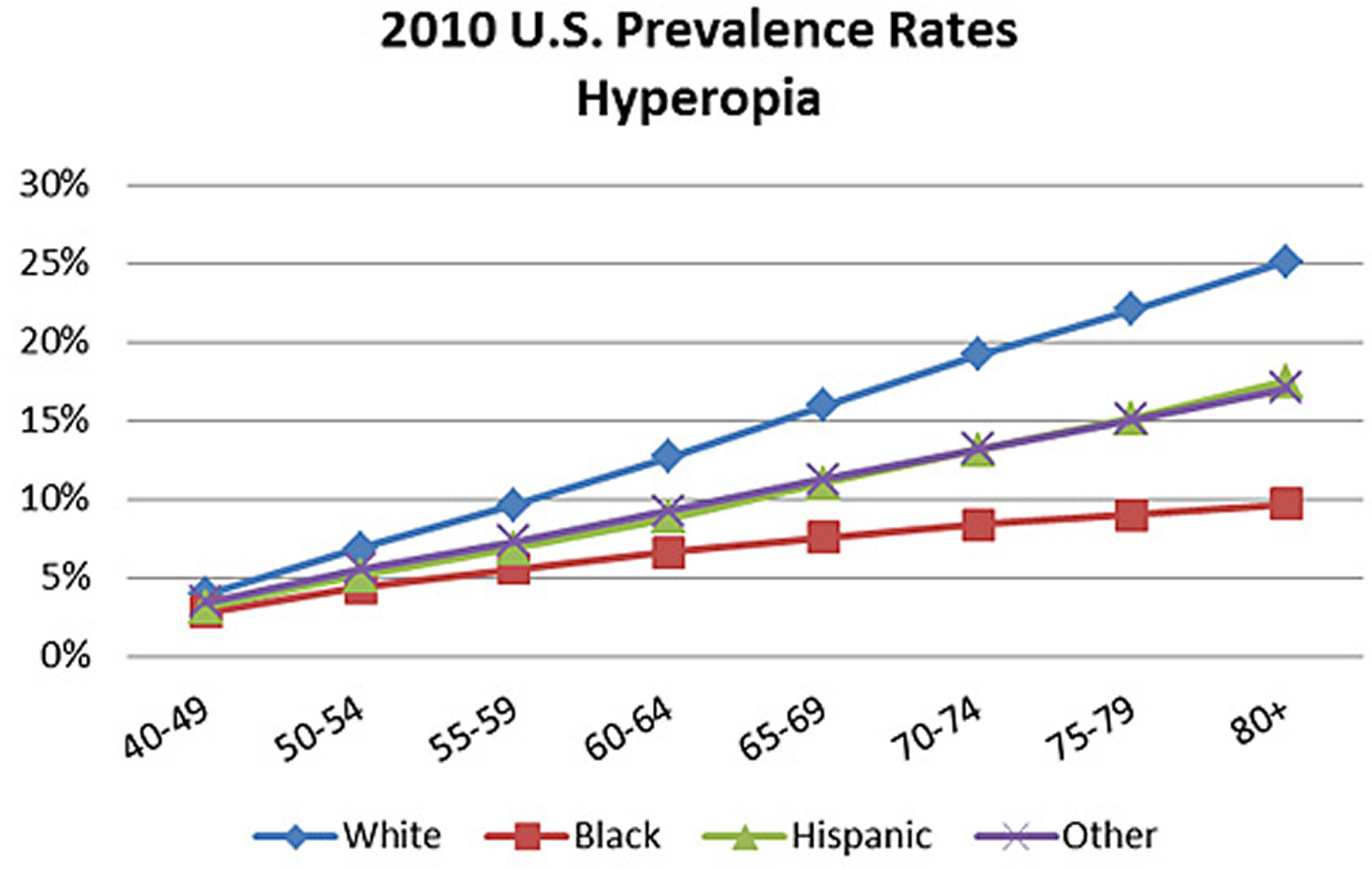 [Source 3]
[Source 3]
Table 1. 2010 U.S. Prevalent Cases of Hyperopia (in thousands) by Age, and Race/Ethnicity
| Age | White | Black | Hispanic | Other | All |
|---|---|---|---|---|---|
| 40-49 | 1,126 | 152 | 201 | 110 | 1,589 |
| 50-54 | 1,090 | 116 | 125 | 80 | 1,411 |
| 55-59 | 1,388 | 120 | 126 | 89 | 1,723 |
| 60-64 | 1,625 | 109 | 121 | 90 | 1,945 |
| 65-69 | 1,545 | 87 | 104 | 75 | 1,811 |
| 70-74 | 1,390 | 69 | 92 | 64 | 1,615 |
| 75-79 | 1,291 | 54 | 77 | 51 | 1,473 |
| 80+ | 2,363 | 77 | 109 | 71 | 2,620 |
| TOTAL | 11,818 | 784 | 955 | 630 | 14,187 |
Figure 5. Eye with Corneal Astigmatism (Irregular Cornea)
Figure 6. Eye with Lenticular Astigmatism (Irregular Lens)
How can I tell if I’m long-sighted?
Mild farsighted vision can be hard to detect because the lens corrects your focus to make close objects clear. But you might find that you have strained or aching eyes or a headache or tiredness after periods of close work.
If you have more severe hyperopia, you might find it hard to focus on close objects.
If you think that you or your child might be farsighted, see your doctor or optometrist for an eye check.
Farsighted (hyperopia) complications
Farsightedness can be associated with several problems, such as:
- Crossed eyes. Some children with farsightedness may develop crossed eyes. Specially designed eyeglasses that correct for part or all of the farsightedness may effectively treat this problem.
- Reduced quality of life. Uncorrected farsightedness can affect your quality of life. You might not be able to perform a task as well as you wish. And your limited vision may detract from your enjoyment of day-to-day activities. In children, untreated farsightedness may cause learning problems.
- Eyestrain. Uncorrected farsightedness may cause you to squint or strain your eyes to maintain focus. This can lead to eyestrain and headaches.
- Impaired safety. For your own safety and that of others, don’t drive or operate mechanical equipment if you have an uncorrected vision problem.
Hyperopia causes
Your eye has two parts that focus images (see Figure 2):
- The cornea, the clear front surface of your eye
- The lens, a clear structure inside your eye that changes shape to help focus on objects
In a perfectly shaped eye, each of these focusing elements has a perfectly smooth curvature, like the surface of a marble. A cornea and lens with such curvature bend (refract) all incoming light to make a sharply focused image directly on the retina, at the back of your eye.
Farsightedness occurs if the eye doesn’t focus light on the retina (the light-sensitive layer at the back of the eye) properly.
This may be because the:
- Eyeball is too short
- Cornea (transparent layer at the front of the eye) is too flat
- Lens inside the eye is unable to focus properly
It’s often not clear what causes these problems, but they’re rarely a sign of any underlying condition.
Sometimes farsightedness may be a result of the genes you inherited from your parents, or a result of the lenses in your eyes becoming stiffer and less able to focus as you get older.
A refractive error
If your cornea or lens isn’t evenly and smoothly curved, light rays aren’t bent (refracted) properly, and you have a refractive error. Farsightedness is one type of refractive error.
Farsightedness occurs when your cornea is curved too little or your eye is shorter than normal. Instead of being focused precisely on your retina, light is focused behind your retina, resulting in a blurry appearance for close-up objects.
Other refractive errors
In addition to farsightedness, other refractive errors include:
- Nearsightedness (myopia). This occurs when your cornea is curved too much or your eye is longer than normal, which makes faraway objects blurry and close objects clear.
- Astigmatism. This occurs when your cornea or lens is curved more steeply in one direction than in another. Uncorrected astigmatism blurs your vision.
Farsighted (hyperopia) Prevention
You can’t prevent farsightedness, but you can help protect your eyes and your vision. Follow these steps:
- Have your eyes checked. Regardless of how well you see, have your eyes checked regularly.
- Control chronic health conditions. Certain conditions, such as diabetes and high blood pressure, can affect your vision if you don’t receive proper treatment.
- Recognize symptoms. Sudden loss of vision in one eye, sudden hazy or blurred vision, flashes of light, black spots, or halos or rainbows around lights may signal a serious medical problem. Seek immediate medical care if you experience any of these signs or symptoms.
- Protect your eyes from the sun. Wear sunglasses that block ultraviolet (UV) radiation. This is especially important if you spend long hours in the sun or are taking a prescription medication that increases your sensitivity to UV radiation.
- Eat healthy foods. Maintain a healthy diet that contains plenty of fruits and vegetables. A diet containing these foods is necessary to maintain a healthy retina, and likely slows the progression of macular degeneration. Eat dark leafy foods and bright-colored fruits and vegetables, such as spinach, kale, carrots, yams and cantaloupe.
- Don’t smoke. Smoking can adversely affect your eye health. Smoking is one of the most important preventable risk factors for developing macular degeneration.
- Use the right glasses. The right glasses optimize your vision. Having regular exams will ensure that your eyeglass prescription is correct.
- Use good lighting. Turning up the lights can improve contrast and help you see better.
Hyperopia (farsighted vision) signs and symptoms
The symptoms of hyperopia vary from person to person. Your eye care professional can help you understand how the condition affects you.
Common signs and symptoms of hyperopia include:
- Headaches
- Eyestrain
- Squinting
- Blurry vision, especially for close objects
Hyperopia diagnosis
An eye care professional can diagnose hyperopia and other refractive errors during a comprehensive dilated eye examination. People with this condition often visit their eye care professional with complaints of visual discomfort or blurred vision.
Hyperopia treatment
Mild long-sightedness, especially in young people, might not need any treatment.
If moderate to severe long-sightedness is not corrected, however, the extra focusing effort required may increase the likelihood of children developing lazy eye (amblyopia) or turned eyes (also known as a squint, or strabismus).
The goal of treating farsightedness is to help focus light on the retina through the use of corrective lenses or refractive surgery.
Hyperopia can be corrected with eyeglasses, contact lenses, or surgery.
- Eyeglasses are the simplest and safest way to correct hyperopia. The most common treatment is glasses, especially for reading and other near work, but sometimes also for distance. Your eye care professional can prescribe lenses that will help correct the problem and help you see your best.
- Contact Lenses work by becoming the first refractive surface for light rays entering the eye, causing a more precise refraction or focus. In many cases, contact lenses provide clearer vision, a wider field of vision, and greater comfort. They are a safe and effective option if fitted and used properly. However, contact lenses are not right for everyone. Discuss this with your eye care professional.
- Refractive Surgery aims to permanently change the shape of the cornea which will improve refractive vision. Surgery can decrease or eliminate dependency on wearing eyeglasses and contact lenses. There are many types of refractive surgeries and surgical options should be discussed with an eye care professional.
- Laser refraction surgery can correct long-sightedness, and might be suitable for adults, although it is not recommended for children.
Corrective lenses
In young people, treatment isn’t always necessary because the crystalline lenses inside the eyes are flexible enough to compensate for the condition. But as you age, the lenses become less flexible and eventually you’ll probably need corrective lenses to improve your near vision.
Wearing corrective lenses treats farsightedness by counteracting the decreased curvature of your cornea or the smaller size (length) of your eye. Types of corrective lenses include:
- Eyeglasses. The variety of eyeglasses is wide and includes bifocals, trifocals, progressive lenses and reading lenses.
- Contact lenses. A wide variety of contact lenses are available — hard, soft, extended wear, disposable, rigid gas permeable and bifocal. Ask your eye doctor about the pros and cons of contact lenses and what might be best for you.
If you’re also having age-related trouble with close vision (presbyopia), monovision contact lenses may be an option for you. With monovision contacts, you may not need correction for the eye you use for distance vision (usually the dominant eye). But a contact lens can be used for close-up vision in your other eye. Some people have trouble adapting to this kind of vision because 3-D vision is sacrificed in order to be able to see both nearby and in the distance clearly. Monovision contacts can be worn intermittently as desired.
Modified monovision contact lenses are another option. With this type of contact lens, you can wear a bifocal contact lens in your nondominant eye and a contact lens prescribed for distance in your dominant eye. You can then use both eyes for distance and one eye for seeing objects nearby.
Refractive surgery
Although most refractive surgical procedures are used to treat nearsightedness, they can also be used for farsightedness. These surgical treatments correct farsightedness by reshaping the curvature of your cornea. Refractive surgery methods include:
- Laser-assisted in-situ keratomileusis (LASIK). LASIK is a procedure in which an ophthalmologist makes a thin, circular hinged flap cut into your cornea. Then your eye surgeon uses an excimer laser to remove layers from the center of your cornea to steepen its domed shape. An excimer laser differs from other lasers in that it doesn’t produce heat. After the laser is used, the thin corneal flap is repositioned.
- Laser-assisted subepithelial keratectomy (LASEK). Instead of creating a flap in the cornea, the surgeon creates a flap involving only the cornea’s thin protective cover (epithelium). Your surgeon will use an excimer laser to reshape the cornea’s outer layers and steepen its curvature and then reposition the epithelial flap. To facilitate healing, you may wear a bandage contact lens for several days after the procedure.
- Photorefractive keratectomy (PRK). This procedure is similar to LASEK, except the surgeon removes the epithelium. It’ll grow back naturally, conforming to your cornea’s new shape. You may need to wear a bandage contact lens for a few days following surgery.
- Conductive keratoplasty (CK). This procedure uses radiofrequency energy to apply heat to tiny spots around the cornea. The effect resembles plastic wrap being stretched by heat. The degree of change in the curvature of the cornea depends on the number and spacing of the spots as well as the way in which the cornea heals after treatment. The results of CK aren’t permanent.
Some of the possible complications that can occur after refractive surgery include:
- Undercorrection or overcorrection of your initial problem
- Visual side effects, such as a halo or starburst appearing around lights
- Dry eye
- Infection
- Rarely, vision loss
Discuss the potential risks and benefits of these procedures with your eye doctor.
LASIK eye surgery for farsightedness
LASIK (Laser-Assisted In Situ Keratomileusis) is a type of laser refractive surgery — the best known and most commonly performed. In general, a special type of cutting laser is used to precisely change the shape of your cornea — the dome-shaped transparent tissue at the front of your eye — to improve vision.
In many cases this removes the need for glasses or contact lenses. Like all surgery, it has risks and possible complications.
Note: There are many types of laser eye surgery offered for vision correction including LASIK, LASEK, PRK, ASLA and SMILE.
Figure 7. LASIK surgery
Note: During LASIK eye surgery, an eye surgeon creates a flap in the cornea (A) — the transparent, dome-shaped surface of the eye that accounts for a large part of the eye’s bending or refracting power. Then the surgeon uses a laser (B) to reshape the cornea, which corrects the refraction problems in the eye (C).
When is LASIK (laser) eye surgery used?
LASIK surgery may be an option for the correction of one of these vision problems:
- Nearsightedness (myopia). When your eyeball is slightly longer than normal or when the cornea curves too sharply, light rays focus in front of the retina and blur distant vision. You can see objects that are close fairly clearly, but not those that are far away.
- Farsightedness (hyperopia). When you have a shorter than average eyeball or a cornea that is too flat, light focuses behind the retina instead of on it. This makes near vision, and sometimes distant vision, blurry.
- Astigmatism. When the cornea curves or flattens unevenly, the result is astigmatism, which disrupts focus of near and distant vision.
If you’re considering LASIK surgery, you probably already wear glasses or contact lenses. Your eye doctor will talk with you about whether LASIK surgery or another similar refractive procedure is an option that will work for you.
Who is NOT suitable for laser eye surgery?
Certain people should NOT have laser eye surgery for vision correction. These include people who:
- are under 18
- have an abnormal cornea
- have a physical condition that impairs healing
- have very dry eyes
- have unstable vision (their glasses prescription changes often)
- have an autoimmune disease
- have diabetes, uncontrolled rheumatic conditions or keratoconus
- have a history of herpes in the eyes
- use certain medications
- carry out activities that risk eye injury e.g. contact sports that may be associated with blows to the face
- have an eye disease called keratoconus, or if you have a family history of it
- have fairly good overall vision
- have severe nearsightedness
- have very large pupils or thin corneas
- have age-related eye changes that cause you to have less-clear vision (presbyopia)
Risks of LASIK eye surgery
Complications that result in a loss of vision are very rare. But certain side effects of LASIK eye surgery, particularly dry eyes and temporary visual disturbances, are fairly common. These usually clear up after a few weeks or months, and very few people consider them to be a long-term problem.
Risks of LASIK include:
- Dry eyes. LASIK surgery causes a temporary decrease in tear production. For the first six months or so after your surgery, your eyes may feel unusually dry as they heal. Dry eyes can reduce the quality of your vision. Your eye doctor might recommend that you use eyedrops during this time. If you experience severe dry eyes, you could opt for another procedure to get special plugs put in your tear ducts to prevent your tears from draining away from the surface of your eyes.
- Glare, halos and double vision. After surgery you may have difficulty seeing at night. You might notice glare, halos around bright lights or double vision. This generally lasts a few days to a few weeks. Even when a good visual result is measured under standard testing conditions, your vision in dim light (such as at dusk or in fog) may be reduced to a greater degree after the surgery than before the surgery.
- Undercorrections. If the laser removes too little tissue from your eye, you won’t get the clearer vision results you were hoping for. Undercorrections are more common for people who are nearsighted. You may need another LASIK procedure within a year to remove more tissue.
- Overcorrections. It’s also possible that the laser will remove too much tissue from your eye. Overcorrections may be more difficult to fix than undercorrections.
- Astigmatism. Astigmatism can be caused by uneven tissue removal. It may require additional surgery, glasses or contact lenses.
- Flap problems. Folding back or removing the flap from the front of your eye during surgery can cause complications, including infection and excess tears. The outermost corneal tissue layer (epithelium) may grow abnormally underneath the flap during the healing process.
- Vision loss or changes. Rarely, you may experience loss of vision due to surgical complications. Some people also may not see as sharply or clearly as previously.
Conditions that increase risks of LASIK surgery
Certain health conditions can increase the risks associated with LASIK surgery or make the outcome less predictable. Doctors may not recommend laser refractive surgery for you if you have certain conditions, including:
- Autoimmune disorders, such as rheumatoid arthritis
- A weakened immune system caused by immunosuppressive medications or HIV
- Persistent dry eyes
- Unstable vision due to medications, hormonal changes, pregnancy, breast-feeding or age
- Keratitis, uveitis, herpes simplex affecting the eye area, glaucoma, cataracts, eye injuries or lid disorders
If you’re considering LASIK surgery, talk to your doctor about your questions and concerns. He or she can explain how the surgery might benefit you and help put the risks in perspective. Your doctor will discuss with you whether you’re a candidate for the procedure.
What you can expect from LASIK eye surgery
Before the procedure
Long-term results from LASIK tend to be best in people who are carefully evaluated before surgery to ensure that they are good candidates for the procedure. Your eye doctor will ask about your medical and surgical history and give you a comprehensive eye examination.
In the eye examination, your doctor will evaluate your vision and look for signs of eye infections, inflammation, dry eyes, large eye pupils, high eye pressure and other eye-health conditions. He or she will also measure your cornea, noting the shape, contour, thickness and any irregularities. This helps your doctor assess whether you can undergo the procedure safely.
Your eye doctor also evaluates which areas of your cornea need reshaping. He or she determines the precise amount of tissue to remove from your cornea. Doctors generally use wavefront-guided technology to evaluate your eye in detail before LASIK surgery. In this test, a scanner creates a highly detailed chart, similar to a topographic map, of your eye. The more detailed the measurements, the more accurate your eye doctor can be in removing corneal tissue.
If you wear contact lenses, which can change the shape of your cornea, you’ll need to completely stop wearing them and wear only your glasses for at least a few weeks before your evaluation and surgery. Your doctor will provide specific guidelines depending on your situation and how long you’ve been a contact lens wearer.
Before surgery, your doctor will discuss the risks and benefits of LASIK, what to expect before and after surgery, and any questions you may have.
Steps you can take to prepare for surgery include:
- Know what surgery may cost you. LASIK surgery is usually considered elective surgery, so most insurance companies won’t cover the cost of the surgery. Be prepared to pay out-of-pocket for your expenses.
- Arrange for a ride home. You’ll need to have someone drive you to and from your place of surgery. Immediately after surgery, you might still feel the effects of medicine given to you before surgery, and your vision may be blurry.
- Skip the eye makeup. Don’t use eye makeup, cream, perfumes or lotions on the day before and the day of your surgery. Your doctor may also instruct you to clean your eyelashes daily or more often in the days leading up to surgery, to remove debris and minimize your risk of infection.
During the procedure
LASIK surgery is usually completed in 30 minutes or less. During the procedure, you lie on your back in a reclining chair. You may be given medicine to help you relax. After numbing drops are placed in your eye, your doctor uses an instrument to hold your eyelids open.
A suction ring placed on your eye just before cutting the corneal flap may cause a feeling of pressure, and your vision may dim a little.
Your eye surgeon uses a small blade or cutting laser to cut a small hinged flap away from the front of your eye. Folding back the flap allows your doctor to access the part of your cornea to be reshaped.
Using a programmed laser, your eye surgeon reshapes parts of your cornea. With each pulse of the laser beam, a tiny amount of corneal tissue is removed. After reshaping the cornea, the surgeon lays the flap back into place. The flap usually heals without stitches.
During the surgery, you’ll be asked to focus on a point of light. Staring at this light helps you keep your eye fixed while the laser reshapes your cornea. You may detect a distinct odor as the laser removes your corneal tissue. Some people describe smelling an odor similar to that of burning hair.
If you need LASIK surgery in both eyes, doctors will generally conduct the procedure on the same day.
After the procedure
Immediately after surgery, your eye might itch, burn and be watery. You’ll probably have blurred vision. You generally will experience little pain, and you’ll usually recover your vision quickly.
You might be given pain medication or eyedrops to keep you comfortable for several hours after the procedure. Your eye doctor might also ask you to wear a shield over your eye at night until your eye heals.
You’ll be able to see after surgery, but your vision won’t be clear right away. It takes about two to three months after your surgery before your eye heals and your vision stabilizes. Your chances for improved vision are based, in part, on how good your vision was before surgery.
You’ll have a follow-up appointment with your eye doctor one to two days after surgery. He or she will see how your eye is healing and check for any complications. Plan for other follow-up appointments during the first six months after surgery as your doctor recommends.
It might be a few weeks before you can start to use cosmetics around your eyes again. You might also have to wait several weeks before resuming strenuous contact sports, swimming or using hot tubs.
Follow your doctor’s recommendations about how soon you can resume your normal activities.
Results
LASIK often offers improved vision without the hassle of glasses or contact lenses. In general, you have a very good chance of achieving 20/25 vision or better after refractive surgery.
More than 8 out of 10 people who’ve undergone LASIK refractive surgery no longer need to use their glasses or contact lenses for most of their activities.
Your results depend on your specific refractive error and other factors. People with a low grade of nearsightedness tend to have the most success with refractive surgery. People with a high degree of nearsightedness or farsightedness along with astigmatism have less predictable results. In some cases, the surgery might result in undercorrection. If this happens, you might need another surgery to achieve the proper correction.
Rarely, some people’s eyes slowly return to the level of vision they had before surgery. This might happen due to certain conditions, such as abnormal wound healing, hormonal imbalances or pregnancy. Sometimes this change in vision is due to another eye problem, such as a cataract. Talk with your doctor about any vision changes.
- American Academy of Ophthalmology. What Is Astigmatism ? https://www.aao.org/eye-health/diseases/what-is-astigmatism[↩]
- The National Eye Institute, the National Institutes of Health. Facts About Astigmatism. https://www.nei.nih.gov/health/errors/astigmatism[↩]
- Hyperopia. https://nei.nih.gov/eyedata/hyperopia[↩][↩]

